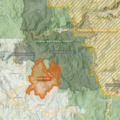| 2022 California wildfires | |
|---|---|
 The smoke plume from the Oak Fire in California as seen by NASA's Aqua satellite on July 23, 2022 | |
| Date(s) | January 21 – October 23 |
| Statistics [1] | |
| Total fires | 7,477 |
| Total area | 331,358 acres (134,096 ha) |
| Impacts | |
| Deaths | 9 |
| Structures destroyed |
|
| Map | |
 A map of every wildfire ≥1,000 acres in area in California in 2022 | |
| Season | |
← 2021 2023 → | |
By the end of the year, a total of 7,477 wildfires had been recorded throughout the U.S. state of California, totaling approximately 331,358 acres (134,096 hectares) across the state. Wildfires killed nine people in California in 2022, destroyed 772 structures, and damaged another 104. The 2020 and 2021 wildfire seasons had the highest and second-highest (respectively) numbers of acres burned in the historical record, with a sharp drop in acreage burned.
Contents
- Background
- Early outlook
- Seasonal fire risk
- Preparation
- Firefighter shortages
- Causes
- Climate change
- Drought
- Forest management and fire suppression
- Wildland–urban interface development
- List of wildfires
- Gallery of maps
- See also
- Notes
- References
- External links
Drastic climatic and ecological conditions, including climate change and long-term drought, had led to the anticipation of another potentially above-average wildfire season on the heels of two previous such seasons in 2020 and 2021. [2] However, while the number of fires to date in 2022 was only slightly below the 5-year average (7,641 fires versus 8,049 fires), the total acreage burned was well below the 5-year average; 363,939 acres burned in 2022 thus far versus the 5-year average of 2,324,096 acres (though that average includes several of California's most significant fire seasons). [3]
Peak fire season in California typically occurs in late summer and/or fall, and effectively ends when significant precipitation occurs across the state. [4] Governor of California Gavin Newsom officially marked "the end of peak wildfire season” in most of the state in mid-November. [5] The quieter fire year was received gratefully by state officials and was highlighted by multiple news outlets, which attributed the downturn in severity largely to fortunate weather patterns, such as well-timed precipitation and favorable wind conditions. [6] [5] Officials were also quick to suggest that a contributing factor might have been several billion dollars invested in wildfire resilience projects, such as prescribed burning and community outreach. [5]
Despite the 'quiet' year as measured in acreage, a number of significant wildfires burned in California in 2022; these include the Oak Fire in Mariposa County, which burned over 180 structures, the McKinney Fire in Siskiyou County, which caused 4 fatalities, and the Mosquito Fire in Placer and El Dorado counties, which was California's largest wildfire of the year.



